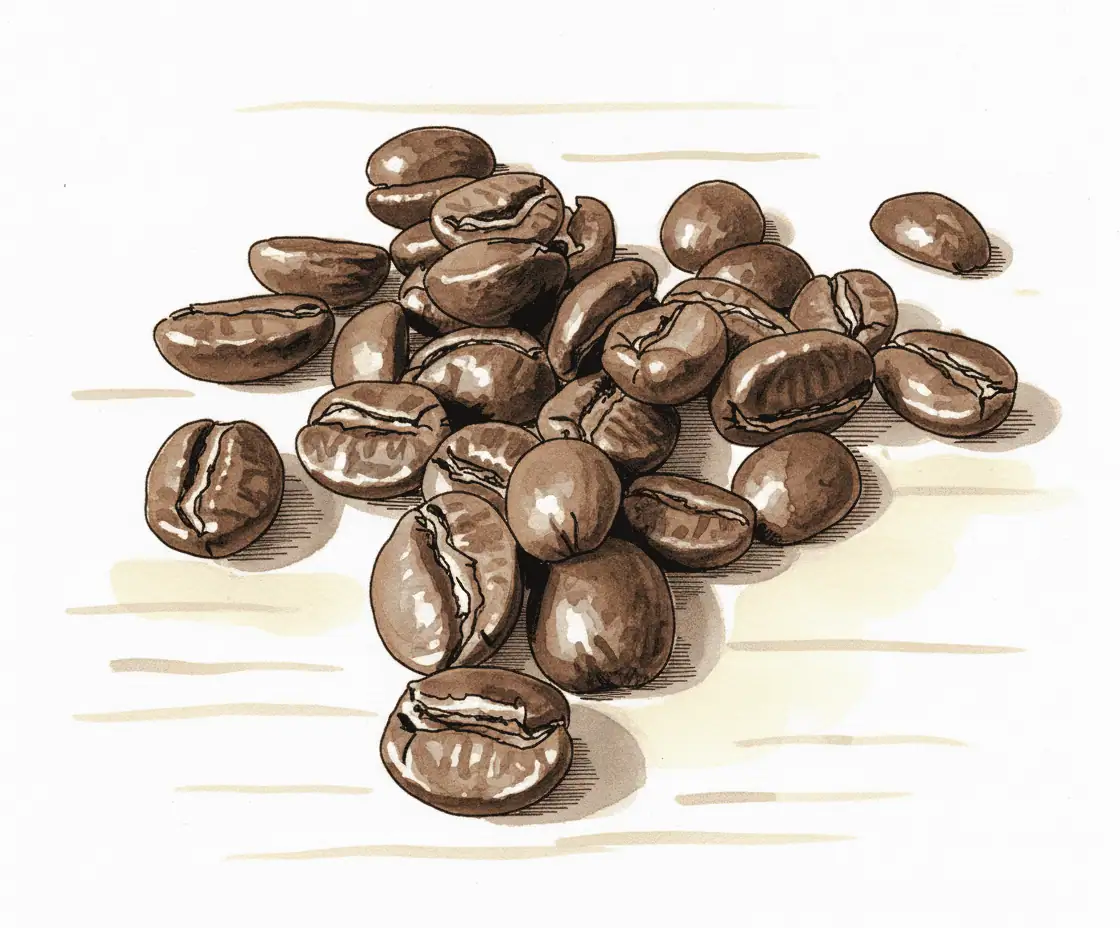Average altitude
Mid altitudes (around 1200–1500 meters) produce beans that offer a balance between sweetness and acidity. Growing conditions are still mild, yet the beans often develop more refinement than at lower elevations. This results in a brighter flavor profile, sometimes with subtle fruit or floral notes. Mid-altitude regions are common in countries such as Colombia, Mexico, and parts of Central America.
Beans

Light Roast
Koffie van El Cajón in Costa Rica, bewerkt door Gabriel Espinoza. Deze Light Roast is lichtbruin en droog, met behoud van terroir en levendige zuren. Natural verwerking versterkt de fruitige zoetheid en complexe aroma’s. De Caturra-variëteit geeft delicate smaken met tonen van honing, lichte citrus, rood fruit en karamel. ZwarteKoffie werkt via direct trade en…

Mae Chedi
Mae Chedi komt uit Chiang Rai in Noord Thailand, waar jonge boeren op 1100 meter specialty koffie verbouwen. De Chiang Mai variëteit, een kruising van SL28 en Catimor, wordt verwerkt via anaerobic white honey of natural met negen dagen fermentatie. Dat geeft een heldere geur van citroengras en smaken van ananas, passievrucht, rode druif, cacao…

Mauricio Salaverria
This specialty coffee from Mauricio Salaverria comes from Finca Himalaya in El Salvador, where ripe cherries are hand-picked and naturally dried. BeanBrothers roasts to a balanced medium roast with variants for filter and espresso. Expect aromas of caramel and red fruit, flavors of cherry, redcurrant, and soft chocolate, with a creamy…

Mauricio Salaverria FILTER
Deze specialty filterkoffie komt van Finca Himalaya in Ataco, Apaneca, op 1550 meter. De vulkanische bodem en schaduw zorgen voor een rijke teelt. De natuurlijke verwerking droogt rijpe bessen langzaam op verhoogde bedden, voor fruitige en zoete accenten. In het kopje proef je karamel, rood fruit en chocolade. De body is medium, de zuurgraad helder…

Melange no. 1
Melange no. 1 is Op Kop's first house blend, made from beans from South America and Africa, grown at altitudes from 600 to 2350 meters. The roaster selects for character, origin, and purpose, roasting medium-dark for a robust, creamy taste. Expect notes of dark chocolate and hazelnut, a full body, and a long aftertaste. The blend combines...

Melange Single Origin
Melange Single Origin komt uit Santana de Vargem in Minas Gerais, waar Coopasv sinds 2000 samenwerkt aan kwaliteitskoffie en sinds 2003 Fairtrade gecertificeerd is. De natural verwerking zorgt voor een volle body, lage aciditeit en fruitige geuren. In de kop zijn notige en zoete tonen te proeven met hazelnoot, karamel, chocolade en een hint sinaasappel.…

Mocca Ethiopië
Mocca Ethiopie uit Sidamo groeit op 1400 meter op vruchtbare vulkanische bodem met circa 1500 millimeter regen en milde temperaturen. De oogst is handgeplukt en zorgvuldig geselecteerd. De branding is medium donker, met volle moutigheid en een boterachtig mondgevoel. Smaakprofiel brengt perzik, abrikoos, sinaasappel en framboos naar voren, met een fijne zware geur. De koffie…

Myanmar
This specialty coffee comes from Hopong, Myanmar, grown by the Pa-O cooperative Three Khuns Village at 1100 to 1600 meters. Since 2018 the farmers have chosen coffee, providing a legal and sustainable income. Borgman en Borgman roasts in Leiden slowly and light to medium, ideal for filter. The natural method lets the cherries rest for two…

Myanmar Hopong – Mong Nwet
Myanmar Hopong Mong Nwet komt uit Shan State op circa 1222 meter. Boeren van de Pa O minderheid telen 100 procent Arabica en werken via direct trade met Indigo Mountain, dat techniek en kwaliteit ondersteunt. De bonen worden handgeplukt en volgen een zongedroogde natural verwerkingsmethode op verhoogde bedden, wat de zoetheid versterkt. Het brandprofiel varieert…

Nicaragua
De Pelikaan Nicaragua is een zachte en aromatische koffie uit Jinotega en Matagalpa op hoogtes vanaf 900 meter, verbouwd op vulkanische bodem onder schaduwbomen zoals Ingas en bananenplanten, verwerkt bij Beneficio Las Trincheras met traditionele wassing en zondroging, 100 procent Arabica met Caturra Catimor en Catuai, smaak met karamel, noten en donkere chocolade en een…

Nicaragua Un Regalo de Dios
Finca Un Regalo de Dios ligt in Mozonte, Nueva Segovia, op 1350-1800 meter. De losse, humusrijke bodem en zorgvuldige droging geven een fruitige natural. De plantage werkt met naturals, honeys en gewassen methoden, sorteert micro-lots en teelt variëteiten als Pacamara en Yellow Catuai, SHG. De smaaknoten omvatten melkchocolade, perzik, abrikoos, kers, rode druif en subtiele…

Outsider
Outsider is een seizoensgebonden Colombiaanse espresso van de boerderij El Encanto, geoogst in 2025 op 1 380 tot 1 800 meter. De moderne espresso roast levert zoetheid en een soepele zuurgraad, met smaken van perzik ijsthee rood fruit honing vanille en amandelkoekjes. Geschikt voor espresso en filter wanneer een stevigere kop gewenst is, en uitmuntend…

Paso Fino
Paso Fino is een Arabica huismelange uit Brazilië Peru Guatemala en Honduras, met intensiteit 7 en een specialty score boven de 80. De medium lichte branding bewaart delicate aromatische tonen, terwijl medium body en balans zorgen voor een volle kop. Verwacht smaken van chocolade karamel en frisse perzik, met florale geurtonen. Geschikt voor espresso cappuccino…
Mid-Altitudes (around 1200–1500 meters)
Looking for a beautiful balance between sweetness and acidity in the cup? Then beans from mid-altitude regions are a great choice. These areas are common in countries like Colombia, Mexico, and parts of Central America. Here you get the best of both worlds: enough coolness for a refined taste, yet enough warmth for good sugar development.
How altitude affects espresso flavor
At elevations of roughly 1200 to 1500 meters, coffee cherries still ripen more slowly than at sea level, but not as slowly as at very high altitudes. This creates a balanced espresso: a mildly sweet base, often with subtle fruity or floral hints, alongside a pleasant, not overly dominant acidity. These coffees are known for their approachable yet refined character. They are often ideal for those who enjoy an espresso with a clear flavor, but without the sometimes “sharp” edge of very high-grown beans.
Chemical composition: balance of sugars and acids
Mid altitudes still give the coffee plant enough coolness to build complexity, yet enough warmth to encourage sweeter notes. The beans generally have a slightly lower density than true high-grown beans, but remain firm enough to develop a wide flavor palette. You will notice the acids are a touch less pronounced, allowing the sweetness to come forward. This can yield a balanced cup of espresso with both freshness and a soft body.
Processing methods: diversity is key
In many regions at these elevations, there is active experimentation with different processing methods. The washed method remains popular, but honey and semi-washed processes are also often used, depending on local traditions and the desired flavor profiles. Thanks to slightly higher temperatures (compared to high mountains), sun-drying beans is often easier. This allows farmers to apply natural or pulped natural methods, which in turn leads to more sweetness and sometimes a hint of fermentation in the taste.
Climate and microclimate
At 1,200 to 1,500 meters, conditions usually mean mild temperatures, regular rainfall, and still plenty of sun. This kind of environment is ideal for coffee shrubs. They are protected from extreme heat, but also from the cold of great heights. As a result, the growing season is stable and fairly predictable. Microclimates arise from local variations in rainfall and hours of sunshine. A shrub on one mountainside can therefore produce slightly different flavor nuances than one on the slope next to it.
Yield and resilience
In general, the yield here is better than at very high elevations, because the plants are less stressed by colder nights or thin air. This means farmers can often produce slightly higher volumes while quality remains high. Moreover, the shrubs can often stay healthy for longer, provided they are well maintained. A stable yield is beneficial for the local community, as farmers’ income is less dependent on erratic harvests.
Choosing coffee varieties
In this altitude band, many Arabica varieties are found, such as Caturra, Colombia, and Bourbon. Farmers often choose plants that strike a good balance between yield and flavor. Some varieties are resistant to diseases like "coffee leaf rust", which is an important factor in areas with higher humidity. This allows farmers to grow with confidence, knowing they will harvest consistently tasty coffee.
Coffee from mid-altitudes is therefore highly recommended for anyone seeking a balanced espresso. Expect subtle fruit or floral notes, complemented by a mildly sweet body. No sharp extremes, but a rich, approachable flavor that many drinkers appreciate.
A selection for those who are open to a lively and complex coffee experience.
